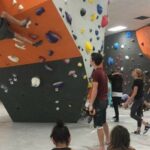Different Features of Belay Devices and How it Can Make Climbing Much Easier -Everything Explained
You understand what I’m talking about if you’ve ever belayed someone for extended amounts of time or spent the entire day climbing. Belaying is truly a pain in the neck. Even after you become accustomed to it, the excessive head tilt that occurs when facing high vertical walls causes your neck to become stiff and sore.
While belaying and continually gazing up, the muscles in the back of your neck strengthen and stiffen, while the muscles at the front of your neck lengthen and weaken. The soreness in the back of the neck is caused by this imbalance.
Another major factor contributing to neck pain after climbing is inflammation. Your vertebrae rub and grind against one another as you strain your neck to glance up at your climbing companion all the time. This soon causes swelling, which swiftly develops into the dull, agonizing ache we are all too familiar with.
We have discussed in detail climbing wear, take a look!
What Is The Solution?
Belay glasses function by reflecting the climber to a mirror in front of your eye, allowing you to maintain the climber’s perspective without continually elevating your head. This may make a long day of crag climbing and belay surprisingly easy on your neck by reducing the neck stain you might otherwise experience. You can always see what the climber is doing above you because of the prism-shaped lenses that are used in their construction.
How Do Belay Glasses Work?
To prevent the neck strain that is frequently associated with belaying, belayers in rock climbing use glasses with prismatic lenses. Simply said, belay glasses eliminate the need for a belayer to crane their neck in order to view the climber. Similar to conventional glasses, belay specs utilize a prism in place of the lens to reflect the climber’s upright image back to the belayer. Many claims that this increases each pitch’s safety, comfort, and even a little amount of coolness. Belay glasses come in many shapes, sizes, colors, and features, and are offered by a wide range of companies.
Is It Worth Buying?
Even low-angle climbs might strain the neck if belay glasses aren’t used. The discomfort of prolonged belaying can become severe as climbs get steeper. Injury to the neck from strain is a condition known as belayer’s neck. Without belay glasses, belayers frequently avoid looking up at their climber the whole ascent to prevent neck stiffness. Even while the climber may not be in immediate danger if you turn your back on him or her, a belay may be less attentive to the climber’s demands. If the climber runs the chance of falling close to a hazard, this might be deadly. To avoid neck pain and provide a safer belay, belay glasses are strongly advised.
Types Of The Belay Glasses
1. Fixed-Prism Glasses
All belay glasses available shared the same optical design: a prism that reflects light twice, once off its mirror-coated bottom and once again off its top. These glasses have fixed prisms. The slope of a low-angle slab climb is set at 60 degrees from the horizontal, which is how they reflect light.
2. Adjustable-Prism Glasses
Regular belay glasses have a view that is 60 degrees off the horizontal because they employ a fixed prism. EyeSend glasses provide the first-ever adjustable prism to address this issue. You may change your perspective from a 60° slab to a 120° overhang by moving this prism. The eyes of a person can also be protected from the sun using adjustable prism glasses. With the adjustable prism, you may examine a considerably broader field of vision without having to crane your neck.
Important Features Of Belay Glasses
- The stability and weight of the frames will depend on how thick or thin they are, and if they have fixed arms or hinges, which might be a weak spot in the construction if the specifications aren’t handled carefully.
- Plastic or metal are also acceptable frame materials.
- The prism’s size is a crucial consideration since it has a big impact on how it works. For the best visual quality, make sure you get a pair of eyeglasses with high-quality prisms.
- Belay glasses may not be able to accommodate belayers who need to wear their prescription glasses due to the way they are made. There are, however, stacking specs that are designed with wearers in mind.
- Whether or not the glasses can be stacked depends on the nose pad. You can wear other glasses in addition to your belaying ones if your glasses have low-profile nose pads.
Disadvantages Of Belay Glasses
The entire reflection technology employed by belay glasses should, in principle, not distort your field of vision. In actuality, the majority of less expensive glasses cause some refraction and distortion. People who are not used to wearing glasses may experience some slight vertigo as a result. Initially, this illusion normally only lasts a few minutes while your eye gets used to the glass. It is brought on by the way wearing glasses will alter how your head motions will affect your range of vision.
Prism seeing is not something that our eyes were made to do. It will thus take some time for you to map your muscle activation to the field of vision that the belay glasses provide. Any initial dizziness usually goes away as you become used to the new method to orient your vision. But for other people, it could persist. If so, either by a different pair of glasses or stop wearing them. While your partner’s life is in your hands or at your belay device, you don’t want to be dizzy.
Can Belay Glasses Makes You A Better Climber
Everyone wants to be the finest climbing partner possible so they can support their friends during their difficult and lengthy climb burnout. We also want to be careful not to short-rope or provide the wrong catch. However, spending more than five minutes gazing up might make anyone uneasy and impatient. Your jaw, neck, and sometimes your lower back begins to hurt. You run a higher chance of missing a crucial visual indication from your climber to tighten your hold on the brake rope or to correct the slack in the rope during these times.
You might not adjust your body position if you are not aware that your climber is ready to fall. You may occasionally get pulled up towards the wall at a pace that might seriously hurt you if their fall force is sufficient. By avoiding their causes, belay glasses reduce the danger of such belay errors. With belay glasses, you can observe your climber without having to crane your neck, preventing any resulting aches and pains. It’s the safest and most comfortable choice.






